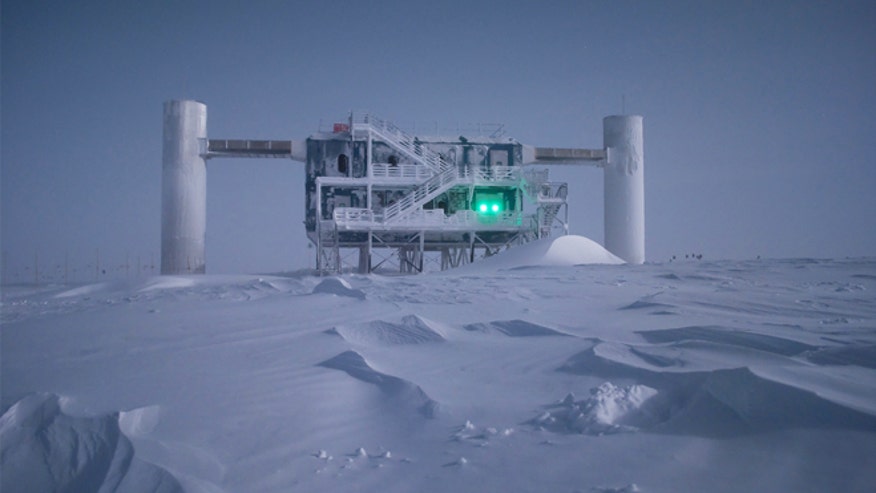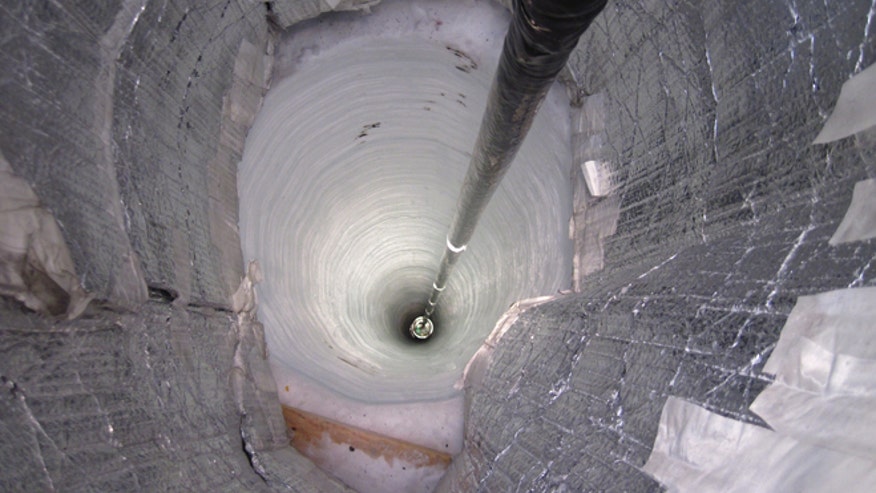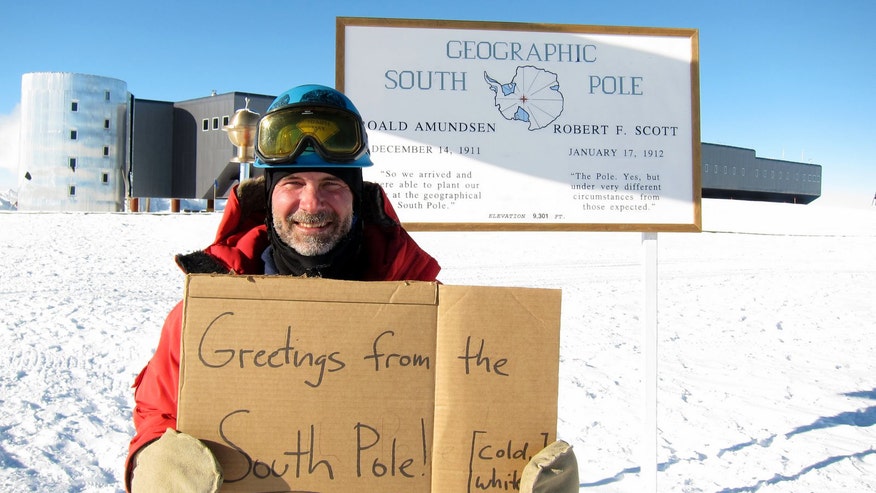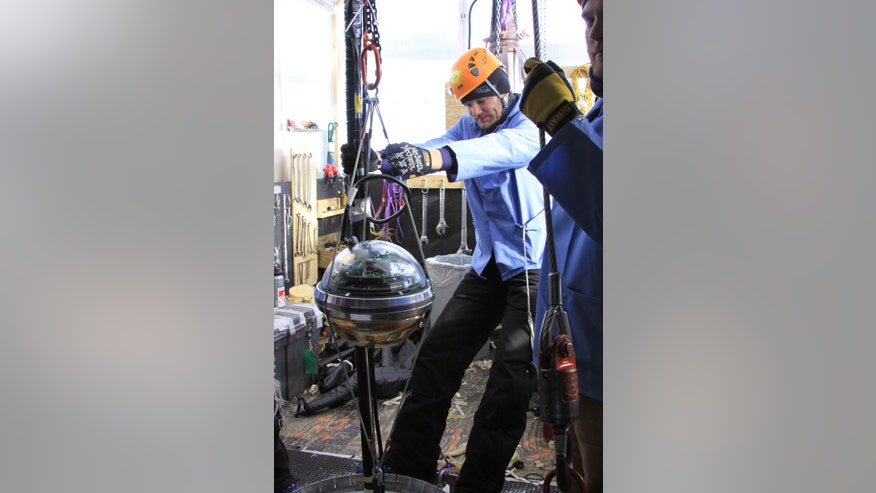ET isn’t out there … he’s already here.
Scientists have discovered travelers from beyond our solar system buried under the ice of the South Pole — not living creatures or space beings but tiny, extra-terrestrial particles known as neutrinos.
“Extra-terrestrial in this context means coming from outside the solar system,” Olga Botner, a professor in the department of physics and astronomy at Uppsala University in Sweden, told FoxNews.com. “For the first time ever we now have evidence for a flux of high-energy neutrinos from outside the solar system.”
Neutrinos are elementary particles like electrons, but they lack an electric charge. These visitors were detected by a massive science telescope buried beneath the frozen Pole and aptly named the IceCube Neutrino Detector, Botner wrote in an article published Thursday in Science magazine.
‘This is the most important particle physics project in the world.’
– IceCube scientist Naoko Kurahashi-Neilson
The IceCube Neutrino Detector is a truly 21st century astronomical observatory — a neutrino telescope constructed at the Amundsen-Scott South Pole Station in Antarctica. Featuring thousands of sensors distributed over a half mile and buried under the ice, the telescope’s construction began in 2002 and was completed in 2010.
Naoko Kurahashi-Neilson, a scientist who joined the IceCube team as it started its operations, told FoxNews.com that the project is crucial to a deeper understanding of physics and the world around us.
“This is the most important particle physics project in the world. As we collect more data over the next 10 years, we may be able to figure out the source of the energy.”
Origin of cosmic rays a mystery
Neutrinos are a byproduct of cosmic rays, which contain high-energy matter and are of mysterious origin. Astrophysicists think these rays may come from exploding stars in other galaxies, but acknowledge that there could be other, unknown sources of the energy out there.
Such rays are hard to track, because these high-energy particles are electrically charged, and thus get deflected by magnetic fields, making them hard to track.
For decades, scientists have been interested in understanding their origins have needed is a messenger from the universe that was not impeded in its travel and that researchers could then track.
Researchers haven’t detected any neutrinos from outside our Solar System since a galactic explosion – a supernova — back in 1987. Neutrinos it emitted came not from Earth but outer space. ;
Last summer, IceCube scientists who had been scanning for high-energy neutrinos since 2010 reported two neutrinos with energies above what’s normally expected in the atmosphere.
These scientists, including ;Kurahashi-Neilson and Botner, then started sifting through the rest of the data, looking for more high-energy neutrino events. The researchers found 26 more, including the most energetic neutrinos ever observed, and each with characteristics similar to those scientists predicted would be found in neutrinos with “extraterrestrial origins.”
This suggests that these 28 neutrinos came here from outside of the solar system.
“The highest neutrino energies we observe now are more than a hundred times higher than the highest energies that can be achieved by terrestrial accelerators,” Botner told FoxNews.com. “Observation of an extraterrestrial flux of high energy neutrinos gives us the possibility to study the universe in a new light.”
“I’d like to be able to say in 20 year’s time that this discovery marked the beginning of the era of neutrino astronomy,” she said.
The IceCube team has been working with ice in Antarctica since 1993, and developed a prototype device that looks for flashes of radiation emitted when charged products of neutrino interacted with the ice and move through it at superluminal speed. The prototype was small, Botner said, and the flux of high-energy neutrinos is very low.
“What we saw then were neutrinos from the Earth’s atmosphere. After 20 years we have now observed a flux of extraterrestrial neutrinos — a dream come true.”
Extra-terrestrials have visited the Earth, in other words — but they look nothing like little green men.
“This ET neutrino ‘rain’ has always been showering the Earth,” Botner said. “It’s only now that we have been able to discover it.”
Most of what science knows about the universe today it has learned by studying electromagnetic radiation, from radio waves to X-rays and gamma-rays. But at very high energies electromagnetic radiation is absorbed by interactions with matter, star light and the cosmic microwave background on its way to us from varied sources.
“There exist regions in the universe which are inaccessible in other ways than by studying high-energy neutrinos,” Botner said. “We are very excited by the possibility of exploring these unknown parts of the universe. However, before this dream can come true we need to improve our techniques. Up to now we have been unable to pinpoint the sources of our high-energy neutrinos. To do that we need to improve our angular resolution — and collect considerably more high energy events.”
Kurahashi-Neilson told FoxNews.com that the team will build, in essence, a map of grids in the sky from the Earth’s point of view, which will pinpoint the origins of these deep-space travelers.
“We have many questions to answer about neutrinos. Do they cluster? Do they come from all over the universe?” Kurahashi-Neilson said. ; “The first indications are that they come from all over.”






